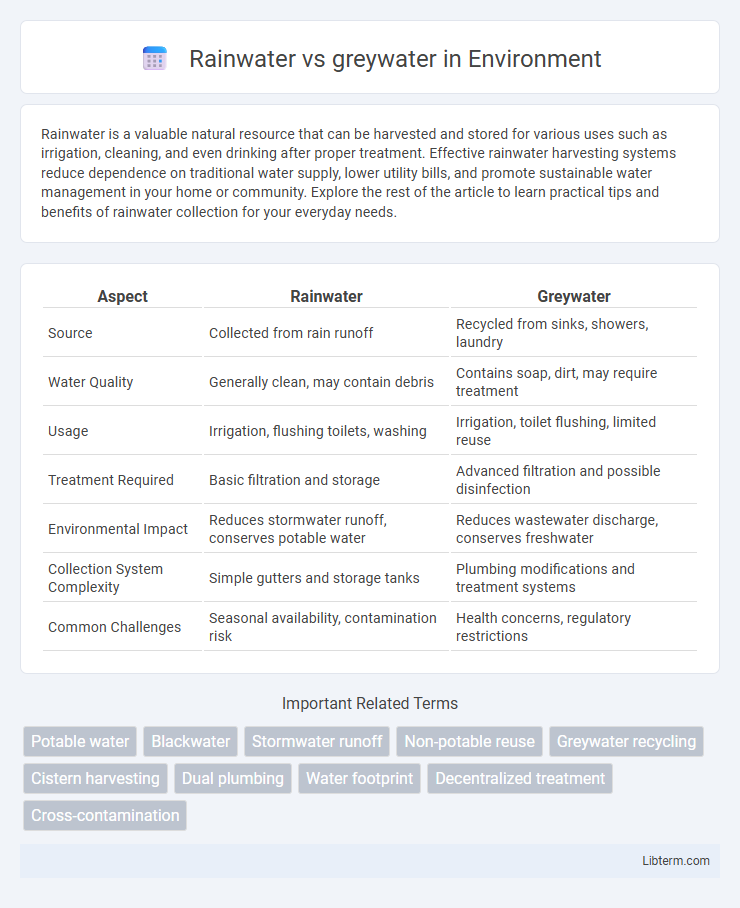Rainwater is a valuable natural resource that can be harvested and stored for various uses such as irrigation, cleaning, and even drinking after proper treatment. Effective rainwater harvesting systems reduce dependence on traditional water supply, lower utility bills, and promote sustainable water management in your home or community. Explore the rest of the article to learn practical tips and benefits of rainwater collection for your everyday needs.
Table of Comparison
| Aspect | Rainwater | Greywater |
|---|---|---|
| Source | Collected from rain runoff | Recycled from sinks, showers, laundry |
| Water Quality | Generally clean, may contain debris | Contains soap, dirt, may require treatment |
| Usage | Irrigation, flushing toilets, washing | Irrigation, toilet flushing, limited reuse |
| Treatment Required | Basic filtration and storage | Advanced filtration and possible disinfection |
| Environmental Impact | Reduces stormwater runoff, conserves potable water | Reduces wastewater discharge, conserves freshwater |
| Collection System Complexity | Simple gutters and storage tanks | Plumbing modifications and treatment systems |
| Common Challenges | Seasonal availability, contamination risk | Health concerns, regulatory restrictions |
Introduction to Rainwater and Greywater
Rainwater is naturally collected precipitation, often harvested from rooftops or open surfaces, and is typically used for irrigation, flushing toilets, and sometimes treated for potable use. Greywater, generated from household activities such as bathing, laundry, and dishwashing, contains low levels of contaminants and is commonly recycled for landscape irrigation and toilet flushing. Both rainwater and greywater serve as sustainable water sources, reducing dependence on municipal water supplies and promoting environmental conservation.
Definitions: What is Rainwater?
Rainwater is naturally occurring water collected directly from precipitation such as rain, snow, sleet, or hail before it reaches the ground, often harvested from rooftops or surfaces for non-potable uses. It is free from many pollutants found in urban runoff and typically requires minimal treatment for irrigation, flushing toilets, or washing. This distinguishes rainwater from greywater, which originates from domestic activities like bathing or laundry and contains organic matter and chemicals needing more extensive treatment.
Understanding Greywater: Sources and Composition
Greywater primarily originates from household activities such as bathing, handwashing, laundry, and kitchen use, excluding toilet waste. Its composition includes a mixture of water with soaps, detergents, food particles, oils, and microorganisms, making it less contaminated than blackwater but requiring proper treatment for reuse. Understanding greywater's specific sources and chemical properties is crucial for designing effective filtration and recycling systems in water conservation efforts.
Key Differences Between Rainwater and Greywater
Rainwater is naturally collected from precipitation, free of household contaminants, and primarily used for irrigation, flushing toilets, and sometimes potable purposes after treatment. Greywater, sourced from household activities like bathing, washing, and laundry, contains organic material, soap, and chemicals requiring onsite treatment before reuse to prevent health risks. The key differences lie in their source, composition, and treatment needs; rainwater is cleaner and requires minimal processing, while greywater is more variable and demands more extensive filtration and disinfection.
Collection Methods for Rainwater and Greywater
Rainwater collection primarily involves rooftop catchments directing water through gutters into storage tanks, utilizing first-flush diverters to improve water quality. Greywater systems capture water from sinks, showers, and laundry through separate plumbing, often treated via filtration or biofiltration units before reuse. Both methods emphasize efficient conveyance and filtration to optimize water reuse for irrigation, toilet flushing, or landscape watering.
Treatment and Filtration Requirements
Rainwater typically requires basic filtration and disinfection to remove debris, sediments, and microbial contaminants before use, often involving first-flush diverters and UV treatment. Greywater contains higher levels of organic matter, oils, and pathogens, necessitating more advanced treatment such as membrane filtration, biological treatment, and chemical disinfection to ensure safety and compliance with health regulations. Effective treatment of both water types enhances suitability for irrigation, flushing, and non-potable applications while minimizing health risks and environmental impact.
Common Uses of Rainwater vs Greywater
Rainwater is commonly used for irrigation, flushing toilets, and outdoor cleaning due to its relatively low contamination levels and easy collection from rooftops. Greywater, originating from sinks, showers, and laundry, is frequently reused for landscape irrigation and toilet flushing but requires treatment to remove soaps and organic matter. Both water sources contribute to reducing potable water demand, supporting sustainable water management in residential and commercial settings.
Environmental Impact and Sustainability
Rainwater harvesting reduces reliance on municipal water supplies and decreases stormwater runoff, minimizing erosion and water pollution. Greywater recycling conserves potable water by reusing wastewater from sinks and showers for irrigation, lowering overall water consumption and reducing wastewater treatment demand. Both practices enhance sustainability by promoting efficient water use and mitigating environmental degradation.
Legal and Safety Considerations
Rainwater harvesting is often subject to local regulations that vary widely, requiring permits and adherence to water quality standards to ensure safety for irrigation or non-potable uses. Greywater, originating from household sources like sinks and showers, typically demands stricter treatment protocols to prevent health risks, and its reuse is regulated to avoid contamination and protect public health. Understanding regional laws and implementing appropriate filtration systems are critical for the safe, legal use of both rainwater and greywater in residential or commercial applications.
Choosing the Right Water Source for Your Needs
Rainwater offers a natural, often purer source ideal for irrigation and non-potable uses, capturing precipitation directly from roofs or surfaces. Greywater, recycled from household activities like washing dishes or bathing, provides a sustainable reuse option for landscape irrigation and toilet flushing, reducing overall water consumption. Assess your local climate, water quality requirements, and intended application to select the most efficient and cost-effective option for your water conservation needs.
Rainwater Infographic

 libterm.com
libterm.com